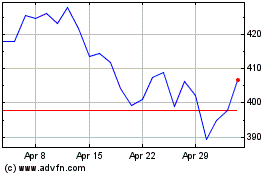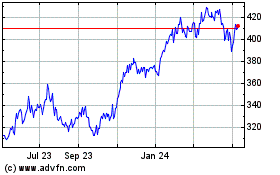Microsoft Profit Jumps, Fueled by Cloud Computing -- Update
July 20 2017 - 5:29PM
Dow Jones News
By Jay Greene
Once written off as a technology has-been, Microsoft Corp.
continued its rebirth as a force in cloud-computing, posting
double-digit increases in its business selling web-based services
to corporate customers.
The venerable software giant has solidified its spot as the No.
2 provider of on-demand computing processing and storage behind
market pioneer Amazon.com Inc. In its fiscal fourth quarter,
Microsoft notched gains in its Azure cloud-computing business and
Office 365, the online version of its widely used productivity
software.
Revenue from the Redmond, Wash., company's Intelligent Cloud
segment, which includes Azure, rose 11% to $7.4 billion. In the
Productivity and Business Processes segment, which includes the
Office franchise, revenue climbed 21% to $8.4 billion.
Microsoft doesn't disclose revenue figures for its Azure and
Office 365 businesses, but it said Azure revenue jumped 97% and
Office 365 revenue rose 43%.
Overall, Microsoft posted $6.51 billion in fourth-quarter net
income, or 83 cents a share, compared with a profit of $3.12
billion, or 39 cents a share, a year ago. Excluding the impact of
revenue deferrals and other items, adjusted earnings climbed to 98
cents from 69 cents a year earlier.
Revenue rose 13% to $23.32 billion and was $24.7 billion when
adjusted to reflect Windows 10 revenue deferrals.
Analysts surveyed by S&P Global Market Intelligence expected
Microsoft to report adjusted per-share earnings of 71 cents on
$24.29 billion in adjusted revenue.
Shares rose 1.5% to $75 in after-hours trading after results
beat expectations. The software giant's shares closed at a record
on Thursday, after setting its previous high a day earlier.
The strides Microsoft has made in the cloud come as its legacy
Windows operating-system business shrinks. Revenue in its More
Personal Computing segment, which includes Windows as well as the
mobile-phone and gaming businesses, slid 2% to $8.8 billion. Last
week, International Data Corp. reported world-wide PC shipments
fell 3.3% in the second quarter, while Gartner Inc. estimated the
drop at 4.3%.
Revenue for Microsoft's Surface line of computers also fell 2%.
Three months ago, that business was hit hard, registering a 26%
revenue decline, which the company attributed to older Surface
computers in the market, as well as increased price
competition.
Since then, Microsoft has introduced a new Surface laptop for
the education market and an update to its Surface Pro tablet-laptop
hybrid device, though those products made their debut with just a
few weeks left in the quarter.
LinkedIn Corp., the professional social network Microsoft
acquired last December for $27 billion, added $1.07 billion in
revenue and posted a $361 million operating loss. Microsoft is
working to connect its business products to LinkedIn, giving sales
representatives using its Dynamics software, for example, tools to
easily mine the professional social network to prospect for
leads.
Like its cloud rivals Amazon and Alphabet Inc.'s Google,
Microsoft is spending lavishly to build giant and expensive data
centers around the world to deliver its cloud services. In the
quarter, Microsoft spent $3.3 billion on capital expenses, with
much of that money going toward its data center expansion. A year
ago, Microsoft had $3.1 billion in capital expenses.
Write to Jay Greene at Jay.Greene@wsj.com
(END) Dow Jones Newswires
July 20, 2017 17:14 ET (21:14 GMT)
Copyright (c) 2017 Dow Jones & Company, Inc.
Microsoft (NASDAQ:MSFT)
Historical Stock Chart
From Mar 2024 to Apr 2024

Microsoft (NASDAQ:MSFT)
Historical Stock Chart
From Apr 2023 to Apr 2024
